Input interpretation

isopropanol
Chemical names and formulas
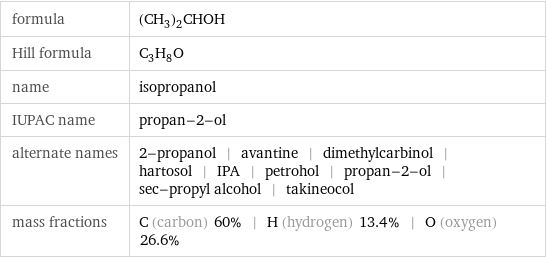
formula | (CH_3)_2CHOH Hill formula | C_3H_8O name | isopropanol IUPAC name | propan-2-ol alternate names | 2-propanol | avantine | dimethylcarbinol | hartosol | IPA | petrohol | propan-2-ol | sec-propyl alcohol | takineocol mass fractions | C (carbon) 60% | H (hydrogen) 13.4% | O (oxygen) 26.6%
Lewis structure
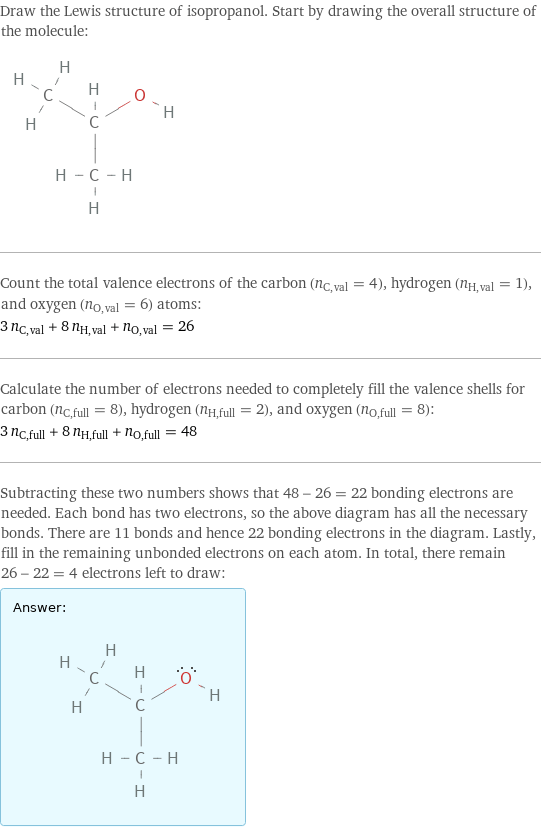
Draw the Lewis structure of isopropanol. Start by drawing the overall structure of the molecule: Count the total valence electrons of the carbon (n_C, val = 4), hydrogen (n_H, val = 1), and oxygen (n_O, val = 6) atoms: 3 n_C, val + 8 n_H, val + n_O, val = 26 Calculate the number of electrons needed to completely fill the valence shells for carbon (n_C, full = 8), hydrogen (n_H, full = 2), and oxygen (n_O, full = 8): 3 n_C, full + 8 n_H, full + n_O, full = 48 Subtracting these two numbers shows that 48 - 26 = 22 bonding electrons are needed. Each bond has two electrons, so the above diagram has all the necessary bonds. There are 11 bonds and hence 22 bonding electrons in the diagram. Lastly, fill in the remaining unbonded electrons on each atom. In total, there remain 26 - 22 = 4 electrons left to draw: Answer: | |
3D structure
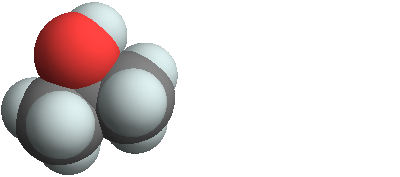
3D structure
Basic properties

molar mass | 60.1 g/mol phase | liquid (at STP) melting point | -89.5 °C boiling point | 82 °C density | 0.785 g/cm^3 solubility in water | miscible dielectric constant | 19.92
Liquid properties (at STP)
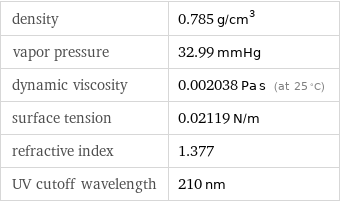
density | 0.785 g/cm^3 vapor pressure | 32.99 mmHg dynamic viscosity | 0.002038 Pa s (at 25 °C) surface tension | 0.02119 N/m refractive index | 1.377 UV cutoff wavelength | 210 nm
Units

Thermodynamic properties
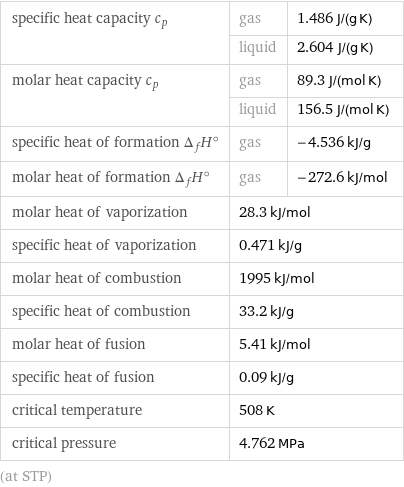
specific heat capacity c_p | gas | 1.486 J/(g K) | liquid | 2.604 J/(g K) molar heat capacity c_p | gas | 89.3 J/(mol K) | liquid | 156.5 J/(mol K) specific heat of formation Δ_fH° | gas | -4.536 kJ/g molar heat of formation Δ_fH° | gas | -272.6 kJ/mol molar heat of vaporization | 28.3 kJ/mol | specific heat of vaporization | 0.471 kJ/g | molar heat of combustion | 1995 kJ/mol | specific heat of combustion | 33.2 kJ/g | molar heat of fusion | 5.41 kJ/mol | specific heat of fusion | 0.09 kJ/g | critical temperature | 508 K | critical pressure | 4.762 MPa | (at STP)
Chemical identifiers

CAS number | 67-63-0 Beilstein number | 635639 PubChem CID number | 3776 PubChem SID number | 24846940 SMILES identifier | CC(C)O InChI identifier | InChI=1/C3H8O/c1-3(2)4/h3-4H, 1-2H3 RTECS number | NT8050000 MDL number | MFCD00011674
NFPA label

NFPA label
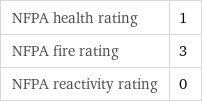
NFPA health rating | 1 NFPA fire rating | 3 NFPA reactivity rating | 0
Safety properties
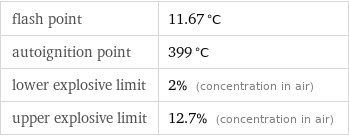
flash point | 11.67 °C autoignition point | 399 °C lower explosive limit | 2% (concentration in air) upper explosive limit | 12.7% (concentration in air)

DOT hazard class | 3 DOT numbers | 1219
Toxicity properties
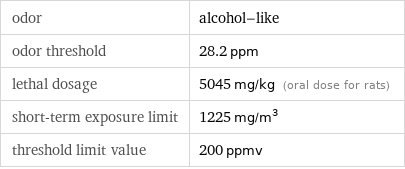
odor | alcohol-like odor threshold | 28.2 ppm lethal dosage | 5045 mg/kg (oral dose for rats) short-term exposure limit | 1225 mg/m^3 threshold limit value | 200 ppmv

probable lethal dose for man | 1 L (liter) long-term exposure limit | 980 mg/m^3 (over 8 hours) RTECS classes | agricultural chemical and pesticide | tumorigen | drug | mutagen | reproductive effector | human data | primary irritant